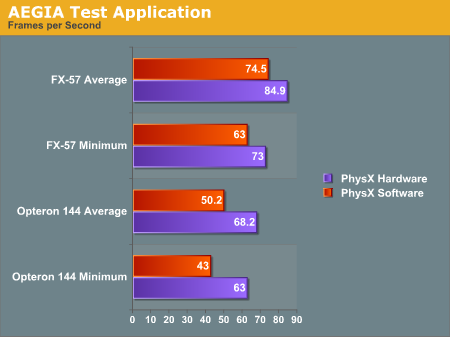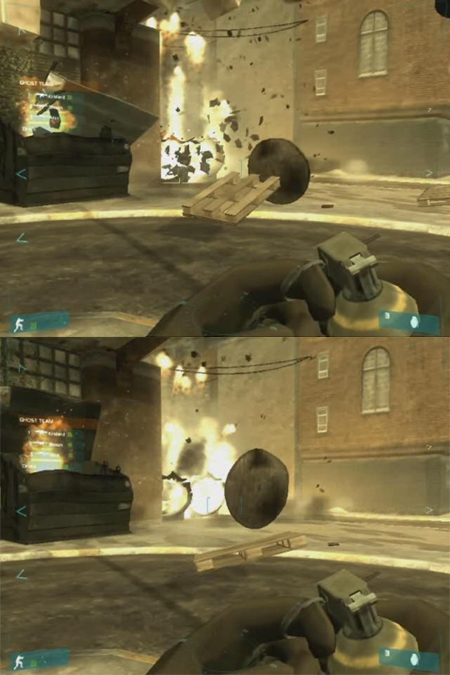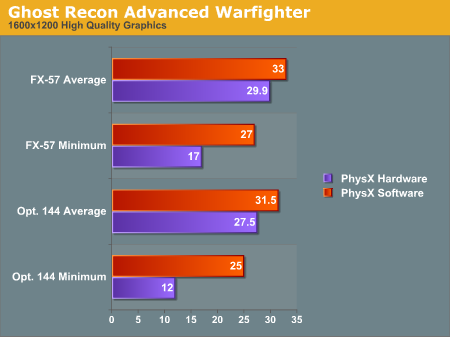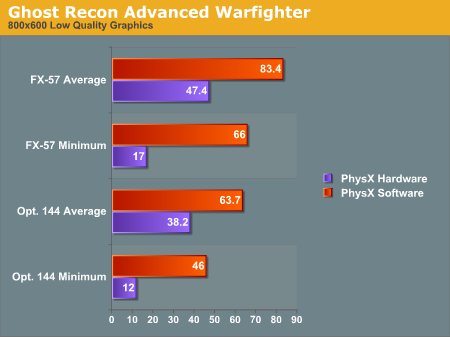Exclusive: ASUS Debuts AGEIA PhysX Hardware
by Derek Wilson on May 5, 2006 3:00 AM EST- Posted in
- GPUs
PhysX Performance
The first program we tested is AGEIA's test application. It's a small scene with a pyramid of boxes stacked up. The only thing it does is shoot a ball at the boxes. We used FRAPS to get the framerate of the test app with and without hardware support.
With the hardware, we were able to get a better minimum and average framerate after shooting the boxes. Obviously this case is a little contrived. The scene is only CPU limited with no fancy graphics going on to clutter up the GPU: just a bunch of solid colored boxes bouncing around after being shaken up a bit. Clearly the PhysX hardware is able to take the burden off the CPU when physics calculations are the only bottleneck in performance. This is to be expected, and doing the same amount of work will give higher performance under PhysX hardware, but we still don't have any idea of how much more the hardware will really allow.
Maybe in the future AGEIA will give us the ability to increase the number of boxes. For now, we get 16% higher minimum frame rates and 14% higher average frame rates by using be AGEIA PhysX card over just the FX-57 CPU. Honestly, that's a little underwhelming, considering that the AGEIA test application ought to be providing more of a best case scenario.
Moving to the slower Opteron 144 processor, the PhysX card does seem to be a bit more helpful. Average frame rates are up 36% and minimum frame rates are up 47%. The problem is, the target audience of the PhysX card is far more likely to have a high-end processor than a low-end "chump" processor -- or at the very least, they would have an overclocked Opteron/Athlon 64.
Let's take a look at Ghost Recon and see if the story changes any.
Ghost Recon Advanced Warfighter
This next test will be a bit different. Rather than testing the same level of physics with hardware and software, we are only able to test the software at a low physics level and the hardware at a high physics level. We haven't been able to find any way to enable hardware quality physics without the board, nor have we discovered how to enable lower quality physics effects with the board installed. These numbers are still useful as they reflect what people will actually see.
For this test, we looked at a low quality setting (800x600 with low quality textures and no AF) and a high quality setting (1600x1200 with high quality textures and 8x AF). We recorded both the minimum and the average framerate. Here are a couple screenshots with (top) and without (bottom) PhysX, along with the results:



The graphs show some interesting results. We see a lower framerate in all cases when using the PhysX hardware. As we said before, installing the hardware automatically enables higher quality physics. We can't get a good idea of how much better the PhysX hardware would perform than the CPU, but we can see a couple facts very clearly.
Looking at the average framerate comparisons shows us that when the game is GPU limited there is relatively little impact for enabling the higher quality physics. This is the most likely case we'll see in the near term, as the only people buying PhysX hardware initially will probably also be buying high end graphics solutions and pushing them to their limit. The lower end CPU does still have a relatively large impact on minimum frame rates, however, so the PPU doesn't appear to be offloading a lot of work from the CPU core.
The average framerates under low quality graphics settings (i.e. shifting the bottleneck from the GPU to another part of the system) shows that high quality physics has a large impact on performance behind the scenes. The game has either become limited by the PhysX card itself or by the CPU, depending on how much extra physics is going on and where different aspects of the game are being processed. It's very likely this is a more of a bottleneck on the PhysX hardware, as the difference between the 1.8 and 2.6 GHz CPU with PhysX is less than the difference between the two CPUs using software PhysX calculations.
If we shift our focus to the minimum framerates, we notice that when physics is accelerated by hardware our minimum framerate is very low at 17 frames per second regardless of the graphical quality - 12 FPS with the slower CPU. Our test is mostly that of an explosion. We record slightly before and slightly after a grenade blowing up some scenery, and the minimum framerate happens right after the explosion goes off.
Our working theory is that when the explosion starts, the debris that goes flying everywhere needs to be created on the fly. This can either be done on the CPU, on the PhysX card, or in both places depending on exactly how the situation is handled by the software. It seems most likely that the slowdown is the cost of instancing all these objects on the PhysX card and then moving them back and forth over the PCI bus and eventually to the GPU. It would certainly be interesting to see if a faster connection for the PhysX card - like PCIe X1 - could smooth things out, but that will have to wait for a future generation of the hardware most likely.
We don't feel the drop in frame rates really affects playability as it's only a couple frames with lower framerates (and the framerate isn't low enough to really "feel" the stutter). However, we'll leave it to the reader to judge whether the quality gain is worth the performance loss. In order to help in that endeavor, we are providing two short videos (3.3MB Zip) of the benchmark sequence with and without hardware acceleration. Enjoy!
One final note is that judging by the average and minimum frame rates, the quality of the physics calculations running on the CPU is substantially lower than it needs to be, at least with a fast processor. Another way of putting it is that the high quality physics may be a little too high quality right now. The reason we say this is that our frame rates are lower -- both minimum and average rates -- when using the PPU. Ideally, we want better physics quality at equal or higher frame rates. Having more objects on screen at once isn't bad, but we would definitely like to have some control over the amount of additional objects.










101 Comments
View All Comments
bob661 - Friday, May 5, 2006 - link
Joe SixPacks aren't gamers. They're email and Word users. People that game know what hardware is required.nullpointerus - Friday, May 5, 2006 - link
That's not how it works. New types of hardware are initially luxury items both in the sense that they are affordable only by a few and way overpriced. When the rich adopt these things, the middle class end up wanting them, and manufacturers find ways to bring the prices down by scaling down the hardware or using technological improvements. So in other words, pipe down, let those who can afford them buy them, and in an few years we may see $50-75 versions for ordinary gamers.Mr Perfect - Saturday, May 6, 2006 - link
I wish I could find the article now, but back a ways there was an interview with Ageia where it was said that prices would span a similar range as video cards. So yes, there will probably be low-end, minrange, and highend card.What I'm concerned about is the people who already are fighting a budget to game. These are the highschool kids with little to no income, the 40 year old with two kids and a morgage, and the casual gamer who's probably just as interested in a $170 PS2. What happens when they have to buy no only an enty level $150 video card, but also a $150 physics card? I can only imagine if gaming was currently limited to only those people with a $300 budget for a 7900GT or X1800 XL that we'd see PC gaming become a very elite selection for "enthusiasts" only.
Hopefully we can get some snazzy physics without increasing the cost of admision so much, either by taking advantage of the dual core CPUs that are even now worming their way into the mainstream PCs, or some sort of new video card technology.
nullpointerus - Sunday, May 7, 2006 - link
Game developers have to eat, too. They won't produce games requiring extravagant hardware. Your fear is irrational. When you go into a doctor's office to get a shot, do you insist that the needle be sterilized right in front of your eyes before it comes anywhere near your skin? No. The doctor wants to eat, so he's not going to blow his eduction and license by reusing needles...Mr Perfect - Monday, May 8, 2006 - link
Well obviously it won't be a problem if it's not required. If it becomes an unnecessary enhancment card, like an X-Fi, then all is well. All I've been saying is if it DOES become a required card there is the possibility for monetary problems for the bread-and-butter casual gamers who fill the servers.Googer - Friday, May 5, 2006 - link
I for one will not be an early adopter for one of these. First generation hardware is always so cool to look at but it's almost always something you do not want to own. DX9 Video Cards are a great example: ATi 9700 PRO Was a great card if you played DX8 games but by the time software rolled around to take advantage of DX9 hardware, the 9700PRO just was not truly cut to handle it. The 9700PRO lacked a ton of features that second generation DX9 Cards had. My point is you should wait for the revision/version 2.0 of this card and you wont regret it. By then programs should be on store shelves to take full advandage of PhysX hardware.Jedi2155 - Monday, May 8, 2006 - link
I think it handled the first gen dx9 games relatively well. Farcry was a great example as it played quite well on my 9700 pro (which lasted me till Sept. '05 when I upgraded to a refurb. x800 pro). It also was able to run most games on max details (although crappy framerates but it was able to do it!). I think the 9700 pro offered it lot for its time and was able to play the 1st gen Dx9 games well enough.munky - Friday, May 5, 2006 - link
Sure, the 9x00 series could handle DX9, just not at maxed out settings. I played Farcry on a 9800xt, and it ran smoothly at medium-high settings. But the physx card is just plain disappointing, since it causes such a performance hit in GRAW, even at cpu-limited resolutions. Either the developers did not code the physics properly, or the physx card is not all that it's hyped up to be. We'll need more games using the ppu to know for sure.rqle - Friday, May 5, 2006 - link
I bought a 9700 Pro, i saw it as so far ahead of ti4600 with its 4x the proformance when AA was apply. First card to play games with AA and AF even if wasnt directx9 games. BUT this ageia thing seem little pointless to me, i actually rather have 2 ATI or 2 Nvidia card, at least this gives you an option, less physics or better graphic experience. comes in handle for those 98% of games that not ageia compatible yet.PeteRoy - Friday, May 5, 2006 - link
I hope this thing will be integrated into video cards mobo or CPU instead of seperated card.